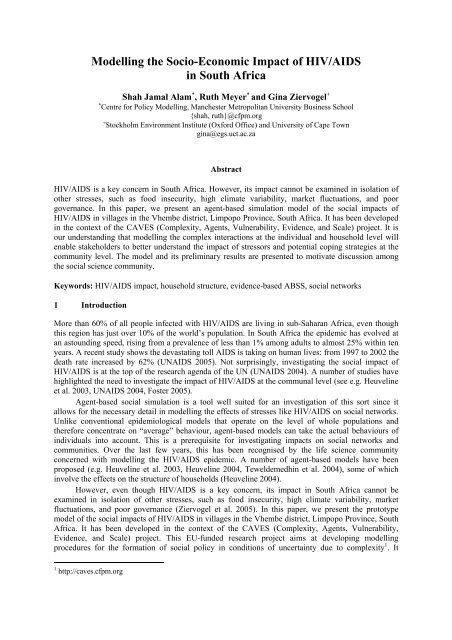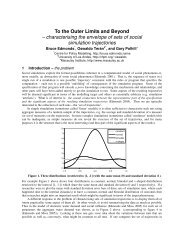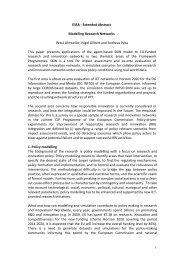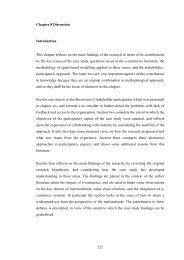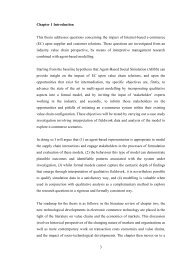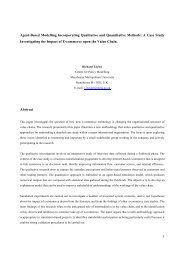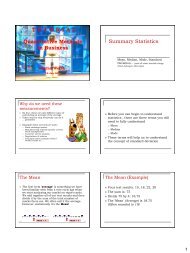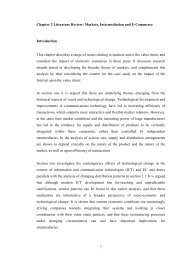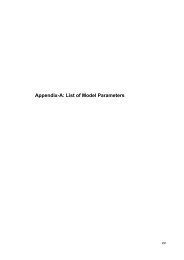Modelling the Socio-Economic Impact of HIV/AIDS in South Africa
Modelling the Socio-Economic Impact of HIV/AIDS in South Africa
Modelling the Socio-Economic Impact of HIV/AIDS in South Africa
You also want an ePaper? Increase the reach of your titles
YUMPU automatically turns print PDFs into web optimized ePapers that Google loves.
<strong>Modell<strong>in</strong>g</strong> <strong>the</strong> <strong>Socio</strong>-<strong>Economic</strong> <strong>Impact</strong> <strong>of</strong> <strong>HIV</strong>/<strong>AIDS</strong><br />
<strong>in</strong> <strong>South</strong> <strong>Africa</strong><br />
Shah Jamal Alam ∗ , Ruth Meyer ∗ and G<strong>in</strong>a Ziervogel +<br />
∗ Centre for Policy <strong>Modell<strong>in</strong>g</strong>, Manchester Metropolitan University Bus<strong>in</strong>ess School<br />
{shah, ruth}@cfpm.org<br />
+ Stockholm Environment Institute (Oxford Office) and University <strong>of</strong> Cape Town<br />
g<strong>in</strong>a@egs.uct.ac.za<br />
Abstract<br />
<strong>HIV</strong>/<strong>AIDS</strong> is a key concern <strong>in</strong> <strong>South</strong> <strong>Africa</strong>. However, its impact cannot be exam<strong>in</strong>ed <strong>in</strong> isolation <strong>of</strong><br />
o<strong>the</strong>r stresses, such as food <strong>in</strong>security, high climate variability, market fluctuations, and poor<br />
governance. In this paper, we present an agent-based simulation model <strong>of</strong> <strong>the</strong> social impacts <strong>of</strong><br />
<strong>HIV</strong>/<strong>AIDS</strong> <strong>in</strong> villages <strong>in</strong> <strong>the</strong> Vhembe district, Limpopo Prov<strong>in</strong>ce, <strong>South</strong> <strong>Africa</strong>. It has been developed<br />
<strong>in</strong> <strong>the</strong> context <strong>of</strong> <strong>the</strong> CAVES (Complexity, Agents, Vulnerability, Evidence, and Scale) project. It is<br />
our understand<strong>in</strong>g that modell<strong>in</strong>g <strong>the</strong> complex <strong>in</strong>teractions at <strong>the</strong> <strong>in</strong>dividual and household level will<br />
enable stakeholders to better understand <strong>the</strong> impact <strong>of</strong> stressors and potential cop<strong>in</strong>g strategies at <strong>the</strong><br />
community level. The model and its prelim<strong>in</strong>ary results are presented to motivate discussion among<br />
<strong>the</strong> social science community.<br />
Keywords: <strong>HIV</strong>/<strong>AIDS</strong> impact, household structure, evidence-based ABSS, social networks<br />
1 Introduction<br />
More than 60% <strong>of</strong> all people <strong>in</strong>fected with <strong>HIV</strong>/<strong>AIDS</strong> are liv<strong>in</strong>g <strong>in</strong> sub-Saharan <strong>Africa</strong>, even though<br />
this region has just over 10% <strong>of</strong> <strong>the</strong> world’s population. In <strong>South</strong> <strong>Africa</strong> <strong>the</strong> epidemic has evolved at<br />
an astound<strong>in</strong>g speed, ris<strong>in</strong>g from a prevalence <strong>of</strong> less than 1% among adults to almost 25% with<strong>in</strong> ten<br />
years. A recent study shows <strong>the</strong> devastat<strong>in</strong>g toll <strong>AIDS</strong> is tak<strong>in</strong>g on human lives: from 1997 to 2002 <strong>the</strong><br />
death rate <strong>in</strong>creased by 62% (UN<strong>AIDS</strong> 2005). Not surpris<strong>in</strong>gly, <strong>in</strong>vestigat<strong>in</strong>g <strong>the</strong> social impact <strong>of</strong><br />
<strong>HIV</strong>/<strong>AIDS</strong> is at <strong>the</strong> top <strong>of</strong> <strong>the</strong> research agenda <strong>of</strong> <strong>the</strong> UN (UN<strong>AIDS</strong> 2004). A number <strong>of</strong> studies have<br />
highlighted <strong>the</strong> need to <strong>in</strong>vestigate <strong>the</strong> impact <strong>of</strong> <strong>HIV</strong>/<strong>AIDS</strong> at <strong>the</strong> communal level (see e.g. Heuvel<strong>in</strong>e<br />
et al. 2003, UN<strong>AIDS</strong> 2004, Foster 2005).<br />
Agent-based social simulation is a tool well suited for an <strong>in</strong>vestigation <strong>of</strong> this sort s<strong>in</strong>ce it<br />
allows for <strong>the</strong> necessary detail <strong>in</strong> modell<strong>in</strong>g <strong>the</strong> effects <strong>of</strong> stresses like <strong>HIV</strong>/<strong>AIDS</strong> on social networks.<br />
Unlike conventional epidemiological models that operate on <strong>the</strong> level <strong>of</strong> whole populations and<br />
<strong>the</strong>refore concentrate on “average” behaviour, agent-based models can take <strong>the</strong> actual behaviours <strong>of</strong><br />
<strong>in</strong>dividuals <strong>in</strong>to account. This is a prerequisite for <strong>in</strong>vestigat<strong>in</strong>g impacts on social networks and<br />
communities. Over <strong>the</strong> last few years, this has been recognised by <strong>the</strong> life science community<br />
concerned with modell<strong>in</strong>g <strong>the</strong> <strong>HIV</strong>/<strong>AIDS</strong> epidemic. A number <strong>of</strong> agent-based models have been<br />
proposed (e.g. Heuvel<strong>in</strong>e et al. 2003, Heuvel<strong>in</strong>e 2004, Teweldemedh<strong>in</strong> et al. 2004), some <strong>of</strong> which<br />
<strong>in</strong>volve <strong>the</strong> effects on <strong>the</strong> structure <strong>of</strong> households (Heuvel<strong>in</strong>e 2004).<br />
However, even though <strong>HIV</strong>/<strong>AIDS</strong> is a key concern, its impact <strong>in</strong> <strong>South</strong> <strong>Africa</strong> cannot be<br />
exam<strong>in</strong>ed <strong>in</strong> isolation <strong>of</strong> o<strong>the</strong>r stresses, such as food <strong>in</strong>security, high climate variability, market<br />
fluctuations, and poor governance (Ziervogel et al. 2005). In this paper, we present <strong>the</strong> prototype<br />
model <strong>of</strong> <strong>the</strong> social impacts <strong>of</strong> <strong>HIV</strong>/<strong>AIDS</strong> <strong>in</strong> villages <strong>in</strong> <strong>the</strong> Vhembe district, Limpopo Prov<strong>in</strong>ce, <strong>South</strong><br />
<strong>Africa</strong>. It has been developed <strong>in</strong> <strong>the</strong> context <strong>of</strong> <strong>the</strong> CAVES (Complexity, Agents, Vulnerability,<br />
Evidence, and Scale) project. This EU-funded research project aims at develop<strong>in</strong>g modell<strong>in</strong>g<br />
procedures for <strong>the</strong> formation <strong>of</strong> social policy <strong>in</strong> conditions <strong>of</strong> uncerta<strong>in</strong>ty due to complexity 1 . It<br />
1 http://caves.cfpm.org
<strong>in</strong>volves case studies <strong>in</strong> Poland, Scotland and <strong>South</strong> <strong>Africa</strong> to provide extensive qualitative and<br />
quantitative evidence with which to constra<strong>in</strong> agent-based social models l<strong>in</strong>ked to biogeophysical<br />
models. The model described here is <strong>the</strong> <strong>in</strong>itial model for <strong>the</strong> <strong>South</strong> <strong>Africa</strong>n case study.<br />
In <strong>the</strong> case study area, <strong>the</strong> Limpopo region <strong>in</strong> <strong>South</strong> <strong>Africa</strong>, <strong>HIV</strong>/<strong>AIDS</strong> is one <strong>of</strong> <strong>the</strong> major<br />
stressors for people’s livelihoods, toge<strong>the</strong>r with climate variability and food <strong>in</strong>security, lead<strong>in</strong>g to a<br />
high vulnerability. Most people <strong>in</strong> <strong>the</strong> area rely on state grants such as pensions or child/orphan grants<br />
and remittances from migrant workers for <strong>the</strong>ir subsistence, s<strong>in</strong>ce agriculture alone is not sufficient.<br />
Death <strong>of</strong> <strong>the</strong> family member receiv<strong>in</strong>g <strong>the</strong> grant or send<strong>in</strong>g money home can <strong>the</strong>refore have a<br />
devastat<strong>in</strong>g effect on a household, to <strong>the</strong> po<strong>in</strong>t <strong>of</strong> dissolution. Orphan children are usually<br />
accommodated by a household <strong>in</strong> <strong>the</strong> extended family. O<strong>the</strong>r strategies for cop<strong>in</strong>g with stressors such<br />
as resource shar<strong>in</strong>g or pool<strong>in</strong>g <strong>of</strong> f<strong>in</strong>ances also rely on social networks <strong>in</strong> <strong>the</strong> community.<br />
2 Prototype model<br />
The model focuses on <strong>the</strong> behaviour <strong>of</strong> <strong>in</strong>dividual agents as well as that <strong>of</strong> households and thus<br />
attempts to take <strong>in</strong>to account both <strong>the</strong> <strong>in</strong>dividual <strong>in</strong>teractions and <strong>the</strong> decisions taken by <strong>the</strong><br />
households. S<strong>in</strong>ce field work for knowledge elicitation had to be done <strong>in</strong> parallel due to organisational<br />
constra<strong>in</strong>ts <strong>of</strong> <strong>the</strong> CAVES project, <strong>the</strong> prototype model is largely based on exist<strong>in</strong>g data from previous<br />
projects undertaken <strong>in</strong> <strong>the</strong> same region; namely <strong>the</strong> UNRAVEL project (Understand<strong>in</strong>g resilient and<br />
vulnerable livelihoods <strong>in</strong> Malawi, <strong>South</strong> <strong>Africa</strong> and Zambia; Ziervogel et al. 2005) and FIVIMS-ZA<br />
(du Toit and Ziervogel 2004), a project assess<strong>in</strong>g <strong>the</strong> feasibility <strong>of</strong> develop<strong>in</strong>g a Food Insecurity and<br />
Vulnerability Information and Mapp<strong>in</strong>g System (FIVIMS 2 ) for <strong>South</strong> <strong>Africa</strong>. With<strong>in</strong> <strong>the</strong> framework <strong>of</strong><br />
<strong>the</strong> latter, a pilot study was undertaken <strong>in</strong> <strong>the</strong> Sekhukhune district, whose data obta<strong>in</strong>ed from a detailed<br />
questionnaire was made available to our team. Unfortunately, it turned out that <strong>the</strong> data perta<strong>in</strong><strong>in</strong>g to<br />
social networks <strong>of</strong> <strong>in</strong>dividuals and/or households was ei<strong>the</strong>r miss<strong>in</strong>g completely or aggregated <strong>in</strong> such<br />
a way that it was impossible for us to <strong>in</strong>fer <strong>the</strong> necessary <strong>in</strong>formation. For <strong>the</strong> prototype model we thus<br />
had to make a number <strong>of</strong> assumptions, which we checked with our doma<strong>in</strong> experts from SEI Oxford.<br />
These will be rectified as soon as empirical data from <strong>the</strong> field work will be available.<br />
Social networks<br />
The model adopts a multi-layer network approach to model <strong>the</strong> social networks. So far, two network<br />
layers are considered, one on <strong>the</strong> level <strong>of</strong> <strong>in</strong>dividuals and one on <strong>the</strong> level <strong>of</strong> households. Individuals<br />
are represented as agents with a network <strong>of</strong> friends. Each <strong>in</strong>dividual is member <strong>of</strong> a household, with<br />
one <strong>of</strong> <strong>the</strong> household members act<strong>in</strong>g as <strong>the</strong> household head. Households have a network <strong>of</strong> social<br />
neighbours with whom <strong>the</strong>y <strong>in</strong>teract. The network is dynamic <strong>in</strong> <strong>the</strong> sense that households may<br />
dis<strong>in</strong>tegrate, while new ones are created, and <strong>the</strong> relationships among <strong>the</strong> members <strong>of</strong> <strong>the</strong> networks<br />
change over time. As actual empirical data on <strong>the</strong> structure <strong>of</strong> <strong>the</strong>se networks is yet miss<strong>in</strong>g, we<br />
assumed a small-world network. This assumption is supported by several o<strong>the</strong>r studies conducted <strong>in</strong><br />
<strong>the</strong> region (e.g. Qu<strong>in</strong>lan et al. 2005, Salomon et al. 2000).<br />
These social neighbours are <strong>the</strong> basis for <strong>in</strong>formal sav<strong>in</strong>gs clubs, known as stokvels. Members<br />
<strong>of</strong> a stokvel pay a mutually agreed sum <strong>in</strong>to <strong>the</strong> club every month. The cumulative sav<strong>in</strong>gs <strong>of</strong> <strong>the</strong><br />
group are <strong>the</strong>n rotated to each member <strong>of</strong> <strong>the</strong> group on a regular basis. After everyone has had <strong>the</strong>ir<br />
turn <strong>in</strong> receiv<strong>in</strong>g <strong>the</strong> contributions, <strong>the</strong> group may disband or start ano<strong>the</strong>r cycle. Female household<br />
heads with higher literacy are usually <strong>the</strong> coord<strong>in</strong>ators <strong>of</strong> <strong>the</strong>se sav<strong>in</strong>gs clubs (Verhoef 2001). We<br />
model this by <strong>in</strong>troduc<strong>in</strong>g <strong>the</strong> role <strong>of</strong> ‘<strong>in</strong>novators’ for a certa<strong>in</strong> proportion <strong>of</strong> agents. Innovators are<br />
able to <strong>in</strong>itiate a sav<strong>in</strong>gs club by <strong>in</strong>vit<strong>in</strong>g o<strong>the</strong>r agents and run <strong>the</strong> club after its formation.<br />
Ano<strong>the</strong>r form <strong>of</strong> pool<strong>in</strong>g f<strong>in</strong>ancial resources are <strong>the</strong> so-called funeral clubs. Households pay a<br />
monthly contribution and receive a lump sum whenever <strong>the</strong>y have to pay for a funeral. Funeral clubs<br />
play an important role because death <strong>in</strong> <strong>the</strong> family not only constitutes an emotional but also a<br />
f<strong>in</strong>ancial burden as all family members are supposed to assemble at <strong>the</strong> place where <strong>the</strong> funeral takes<br />
2 http://www.fivims.net/
place. Whilst <strong>the</strong>re, <strong>the</strong>re must be provision for food and o<strong>the</strong>r basic essentials (Ziervogel et al. 2005).<br />
Unlike <strong>the</strong> stokvels, funeral clubs are <strong>in</strong>stitutionalised and thus not <strong>in</strong>itiated by <strong>in</strong>dividual agents. In<br />
<strong>the</strong> model this is treated by creat<strong>in</strong>g funeral clubs with <strong>in</strong>itial funds at <strong>the</strong> start <strong>of</strong> <strong>the</strong> simulation. The<br />
number <strong>of</strong> clubs is a parameter <strong>of</strong> <strong>the</strong> model.<br />
Orthogonally to <strong>the</strong> network layers <strong>of</strong> friends and social neighbours is <strong>the</strong> hierarchical family<br />
structure. As stated above, each <strong>in</strong>dividual agent is a member <strong>of</strong> a household. Households <strong>in</strong> turn form<br />
clusters which represent <strong>the</strong> extended family. This comes <strong>in</strong>to play when a household dissolves due to<br />
<strong>the</strong> death <strong>of</strong> all care-provid<strong>in</strong>g adults, leav<strong>in</strong>g <strong>the</strong> dependants (orphan children and possibly any<br />
seniors without <strong>in</strong>come) beh<strong>in</strong>d. If this happens, an accommodat<strong>in</strong>g household has to be found. This<br />
search uses <strong>the</strong> family hierarchy to determ<strong>in</strong>e <strong>the</strong> nearest liv<strong>in</strong>g relative who is able to accommodate<br />
<strong>the</strong> surviv<strong>in</strong>g dependants. If <strong>the</strong>re is none <strong>in</strong> <strong>the</strong> extended family, <strong>the</strong> search is expanded to <strong>the</strong><br />
networks <strong>of</strong> neighbours and friends.<br />
Household <strong>in</strong>come<br />
In contrast to many o<strong>the</strong>r countries <strong>in</strong> <strong>Africa</strong>, <strong>South</strong> <strong>Africa</strong> has a social support system provid<strong>in</strong>g<br />
grants to at least some <strong>of</strong> <strong>the</strong> people <strong>in</strong> need. In <strong>the</strong> case study area, grants are a ma<strong>in</strong> source <strong>of</strong><br />
<strong>in</strong>come; pension grants have been found to support entire households (Ziervogel et al. 2005). A<br />
significant proportion <strong>of</strong> <strong>the</strong> grant money is spent on food, followed by transport and medical<br />
expenses. In <strong>the</strong> model we currently <strong>in</strong>clude four basic types <strong>of</strong> grants as listed <strong>in</strong> table 1. A<br />
component represent<strong>in</strong>g a state <strong>in</strong>stitution decides at each time step whe<strong>the</strong>r an <strong>in</strong>dividual is to be<br />
awarded a grant or not.<br />
Grant type<br />
Child grant<br />
Orphan grant<br />
Disability grant<br />
Pension<br />
Eligibility criteria<br />
For children ≤ 8 years suffer<strong>in</strong>g from <strong>HIV</strong>/<strong>AIDS</strong><br />
For orphan children until <strong>the</strong> age <strong>of</strong> 15 years<br />
For adults suffer<strong>in</strong>g from <strong>HIV</strong>/<strong>AIDS</strong><br />
For seniors over 55 (women) or 60 (men) years<br />
Table 1: Grant types and <strong>the</strong>ir criteria<br />
Ano<strong>the</strong>r major source <strong>of</strong> <strong>in</strong>come are remittances sent home by migrant workers to support <strong>the</strong>ir<br />
families (Posel 2001, Posel and Casale 2003). <strong>Modell<strong>in</strong>g</strong> migration and remittances is important, as<br />
both <strong>the</strong> spread <strong>of</strong> <strong>the</strong> epidemic and <strong>the</strong> <strong>in</strong>come <strong>the</strong> households receive from migrants is impacted by<br />
<strong>the</strong> prevalence <strong>of</strong> <strong>HIV</strong>/<strong>AIDS</strong>. In <strong>the</strong> current version <strong>of</strong> <strong>the</strong> model, only adult male agents are<br />
considered eligible to become migrant workers. The proportion <strong>of</strong> eligible <strong>in</strong>dividuals actually gett<strong>in</strong>g<br />
work away from <strong>the</strong> village can be set as a model parameter.<br />
<strong>HIV</strong>/<strong>AIDS</strong><br />
One way to model <strong>the</strong> <strong>HIV</strong>/<strong>AIDS</strong> spread is through agents’ sexual activities, which requires data<br />
through fieldwork. There have been several epidemiological models address<strong>in</strong>g this issue (e.g.<br />
Heuvel<strong>in</strong>e et al. 2003, Teweldemedh<strong>in</strong> et al. 2004, Palloni 1995, Salomon et al. 2000, Handcock et al.<br />
2003). Due to lack <strong>of</strong> empirical data we have so far adopted a distribution-based approach for <strong>the</strong><br />
prototype model, giv<strong>in</strong>g <strong>the</strong> <strong>in</strong>cidence for every time step based on <strong>the</strong> ‘Gamma’ distribution<br />
(Salomon et al. 2000). This will be validated once <strong>the</strong> necessary data is available.<br />
To model <strong>the</strong> decay <strong>in</strong> health <strong>of</strong> an <strong>in</strong>fected <strong>in</strong>dividual, <strong>the</strong> Sigmoid (S-) function is applied. We<br />
consider an <strong>in</strong>cubation period <strong>of</strong> 18 months on average and a median time <strong>of</strong> 8-9 years from <strong>in</strong>fection<br />
to death, as reported by <strong>the</strong> UN<strong>AIDS</strong> (2004).
Agriculture: A comb<strong>in</strong>ed declarative and procedural approach<br />
To cover all agricultural aspects we obta<strong>in</strong>ed an agent-based cropp<strong>in</strong>g model from SEI (Bharwani et<br />
al. 2005), which models crop choices dependent on climate experiences and wea<strong>the</strong>r forecasts, <strong>the</strong><br />
growth <strong>of</strong> <strong>the</strong> chosen crop, harvest and subsequent market transactions. We adapted this model to a<br />
package to be used as a component <strong>in</strong> o<strong>the</strong>r agent-based models. This <strong>in</strong>cluded solv<strong>in</strong>g some <strong>of</strong> <strong>the</strong><br />
implementation problems already identified by <strong>the</strong> SEI team. The imperatively implemented decision<br />
process was extracted and transformed <strong>in</strong>to rules, so that <strong>the</strong> agents’ decisions about which crop to<br />
plant when are now modelled declaratively. It is our understand<strong>in</strong>g that declarative modell<strong>in</strong>g is <strong>of</strong>ten<br />
<strong>the</strong> most appropriate technique to capture social phenomena (Moss and Edmonds 2005) whereas many<br />
physical or biological processes are best described by numerically based formalisms.<br />
We differentiate two different types <strong>of</strong> households, poor and better <strong>of</strong>f, with different sets <strong>of</strong><br />
rules. Poor households plant mostly maize for subsistence. They try to m<strong>in</strong>imise <strong>the</strong>ir risk, which is<br />
why <strong>the</strong>y rely on <strong>the</strong> wea<strong>the</strong>r forecast and only experiment with plant<strong>in</strong>g <strong>the</strong> more expensive cash<br />
crops like butternut and cabbage on part <strong>of</strong> <strong>the</strong>ir plots when <strong>the</strong>y’ve got enough money to spare.<br />
Households who are better <strong>of</strong>f are basically pr<strong>of</strong>it oriented, so <strong>the</strong>y plant only cash crops and buy <strong>the</strong>ir<br />
maize. Examples <strong>of</strong> <strong>the</strong> rules govern<strong>in</strong>g <strong>the</strong>se behaviours are listed below <strong>in</strong> pseudo-code; <strong>the</strong> first two<br />
relate to poor households, <strong>the</strong> last one to wealthier households:<br />
(rule choose-crop-season-1-poor-1<br />
(month 9)<br />
(household (poor true) (cash < 435))<br />
=><br />
(plant (maize (area 0.25) (cost 0)))<br />
)<br />
(rule choose-crop-season-1-poor-4<br />
(month 9)<br />
(forecast dry)<br />
(household (poor true) (us<strong>in</strong>g-forecast true) (cash >= 570))<br />
=><br />
(plant (maize (area 0.25) (cost 0)) (butternut (area 0.75) (cost 255)))<br />
)<br />
(rule choose-crop-season-2-better-<strong>of</strong>f<br />
(month 1)<br />
(forecast dry)<br />
(household (poor false) (us<strong>in</strong>g-forecast true) (cash >= 630))<br />
=><br />
(plant (cabbage (area 1.0) (cost 180)))<br />
)<br />
The model is implemented <strong>in</strong> Java/Repast 3 , us<strong>in</strong>g <strong>the</strong> Repast scheduler, graphical user <strong>in</strong>terface and<br />
network library. The declarative component <strong>in</strong>tegrates JESS (Java Expert System Shell 4 ), a rule eng<strong>in</strong>e<br />
and script<strong>in</strong>g environment developed at Sandia National Laboratories by Ernest Friedman-Hill. We<br />
found that <strong>the</strong> most efficient way to apply JESS is to use one rule <strong>in</strong>terpreter for all agents, which is<br />
run once every time step. All agents <strong>of</strong> a type share one set <strong>of</strong> rules. For every agent (<strong>in</strong> this case,<br />
household) <strong>the</strong>re is a correspond<strong>in</strong>g fact on which <strong>the</strong> rules operate. This results <strong>in</strong> a rule fir<strong>in</strong>g once<br />
for every match<strong>in</strong>g fact.<br />
Us<strong>in</strong>g <strong>the</strong> declarative approach enables a modeller to easily trace which rules fired under what<br />
conditions at a particular time step. This <strong>in</strong> turn allows for a better understand<strong>in</strong>g <strong>of</strong> <strong>the</strong> processes<br />
<strong>in</strong>herent <strong>in</strong> a model, thus support<strong>in</strong>g not only <strong>the</strong> model’s validation but also facilitat<strong>in</strong>g its<br />
communication to stakeholders.<br />
3 http://repast.sourceforge.net/<br />
4 http://herzberg.ca.sandia.gov/jess/
3 First Results<br />
In this paper, we solely present prelim<strong>in</strong>ary results from <strong>the</strong> prototype model. After <strong>the</strong> <strong>in</strong>itial<br />
simulation runs used to verify <strong>the</strong> model implementation, we started to explore different scenarios.<br />
One such scenario <strong>in</strong>vestigates <strong>the</strong> effects <strong>of</strong> grants on <strong>the</strong> households. Receiv<strong>in</strong>g a grant affects <strong>the</strong><br />
survival <strong>of</strong> <strong>the</strong> household significantly. Without farm<strong>in</strong>g, where grants and remittances rema<strong>in</strong> <strong>the</strong><br />
only source <strong>of</strong> <strong>in</strong>come, any fur<strong>the</strong>r grant helps <strong>the</strong> households cope with expenses for subsistence,<br />
health care and funerals for a much longer time.<br />
Figure 1 shows <strong>the</strong> results <strong>of</strong> a simulation run (900 months), where children are only eligible for<br />
a grant if <strong>the</strong>y are orphans suffer<strong>in</strong>g from <strong>HIV</strong>/<strong>AIDS</strong>. With 100 <strong>in</strong>itial households and <strong>the</strong> probability<br />
<strong>of</strong> obta<strong>in</strong><strong>in</strong>g work outside <strong>the</strong> village set to 40%, <strong>the</strong> social networks <strong>of</strong> <strong>the</strong> households (top left corner<br />
<strong>of</strong> figure 1) show a high dissolution rate <strong>of</strong> <strong>in</strong>itial households (green), with a significantly high number<br />
<strong>of</strong> accommodat<strong>in</strong>g households (blue). Membership <strong>in</strong> funeral clubs <strong>in</strong>creases rapidly, as shown <strong>in</strong> <strong>the</strong><br />
top right <strong>of</strong> figure 1, due to households experienc<strong>in</strong>g an <strong>in</strong>crease <strong>in</strong> <strong>the</strong> deaths <strong>of</strong> family members<br />
(bottom right chart), f<strong>in</strong>ally lead<strong>in</strong>g to dissolution <strong>of</strong> households (bottom left chart).<br />
Figure 1: <strong>Impact</strong> on <strong>the</strong> households’ structure with no child grant and restricted orphan grant.<br />
Figure 2: <strong>Impact</strong> on <strong>the</strong> households’ structure with no restriction on grants.
In a different sett<strong>in</strong>g, as represented <strong>in</strong> Figure 2, availability <strong>of</strong> <strong>the</strong> child and orphan grants (see<br />
table 1) was not restricted. The households were able to persist much longer than <strong>in</strong> <strong>the</strong> experiment<br />
shown <strong>in</strong> Figure 1. Moreover, as <strong>the</strong> top-right chart <strong>in</strong> Figure 2 shows, <strong>the</strong> <strong>in</strong>crease <strong>in</strong> <strong>the</strong> overall<br />
memberships <strong>of</strong> <strong>the</strong> funeral clubs reached its maximum much later than <strong>in</strong> <strong>the</strong> previous case.<br />
The anecdotal evidence shows that <strong>the</strong> extended family networks are very strong. Often children<br />
stay <strong>in</strong> <strong>the</strong>ir parents’ households even when <strong>the</strong>y are married and have children <strong>the</strong>mselves. Household<br />
members with no adult to look after <strong>the</strong>m are <strong>of</strong>ten taken care <strong>of</strong> by ano<strong>the</strong>r household <strong>in</strong> <strong>the</strong> extended<br />
family. To <strong>in</strong>vestigate <strong>the</strong>se effects we used a fur<strong>the</strong>r two scenarios. In <strong>the</strong> first one, each household<br />
was randomly assigned highly clustered family l<strong>in</strong>ks. Fur<strong>the</strong>r l<strong>in</strong>ks are <strong>the</strong>n established over <strong>the</strong><br />
simulation run as a result <strong>of</strong> marriages <strong>in</strong> <strong>the</strong> community. In <strong>the</strong> second scenario, used as a lower<br />
bound to possible network structures, extended family ties are solely established via marriage. In both<br />
scenarios marriages are constra<strong>in</strong>ed by <strong>the</strong> availability <strong>of</strong> partners from <strong>the</strong> eligible age range <strong>in</strong> <strong>the</strong><br />
community and <strong>the</strong> money (lebola), which <strong>the</strong> groom has to pay <strong>the</strong> bride’s family.<br />
Figure 3 shows snapshots <strong>of</strong> <strong>the</strong> simulation runs for <strong>the</strong> two different scenarios at year 30 <strong>of</strong> a<br />
90 year (1080 months) simulation period. The simulation was set up for 200 <strong>in</strong>itial households, with<br />
sizes vary<strong>in</strong>g from 5 to 9 members. The number <strong>of</strong> funeral clubs was set fixed to 9 and <strong>the</strong> stokvels<br />
where allowed to start over aga<strong>in</strong> after complet<strong>in</strong>g a cycle.<br />
Figure 3: A snapshot <strong>of</strong> <strong>the</strong> household social l<strong>in</strong>ks, extended family network, sav<strong>in</strong>gs clubs<br />
memberships and time series chart. (Left) with highly clustered <strong>in</strong>itial extended family l<strong>in</strong>ks; (right)<br />
extended family l<strong>in</strong>ks formed only as result <strong>of</strong> marriages dur<strong>in</strong>g <strong>the</strong> run.<br />
In <strong>the</strong> first scenario, any dissolved households could be accommodated, while <strong>in</strong> <strong>the</strong> second<br />
scenario most households failed to f<strong>in</strong>d an accommodator <strong>in</strong> <strong>the</strong> much sparser extended family<br />
network, as is to be expected. On <strong>the</strong> o<strong>the</strong>r hand, <strong>the</strong> number <strong>of</strong> sav<strong>in</strong>gs clubs does not seem to be<br />
<strong>in</strong>fluenced by <strong>the</strong> density <strong>of</strong> <strong>the</strong> households’ family l<strong>in</strong>ks.<br />
Figure 4 shows <strong>the</strong> sav<strong>in</strong>gs clubs network at different time steps <strong>of</strong> a simulation run with <strong>the</strong><br />
same sett<strong>in</strong>gs. A triangle represents <strong>the</strong> smallest possible club formation among three female<br />
household heads. Note that <strong>the</strong>re are cases where a third l<strong>in</strong>k is miss<strong>in</strong>g <strong>in</strong> <strong>the</strong> snapshots. This happens<br />
when a club is no longer viable and perishes <strong>in</strong> <strong>the</strong> follow<strong>in</strong>g time step.<br />
The deaths time series chart <strong>in</strong> Figure 5 expla<strong>in</strong>s why <strong>the</strong> number <strong>of</strong> stokvels decl<strong>in</strong>es so<br />
noticeably over time. While <strong>HIV</strong>/<strong>AIDS</strong> is <strong>the</strong> major cause <strong>of</strong> deaths occurr<strong>in</strong>g <strong>in</strong> <strong>the</strong> system <strong>the</strong>re is<br />
also a high rate <strong>of</strong> deaths due to malnutrition and old age (large blue peaks <strong>in</strong> <strong>the</strong> middle <strong>of</strong> <strong>the</strong> time<br />
series). Increas<strong>in</strong>g health expenses put additional pressure on households to pull out <strong>of</strong> sav<strong>in</strong>gs clubs.<br />
The highly clustered frequency <strong>of</strong> deaths <strong>in</strong> <strong>the</strong> second half <strong>of</strong> <strong>the</strong> simulation run is probably a – if not<br />
<strong>the</strong> – major cause <strong>of</strong> <strong>the</strong> decl<strong>in</strong>e <strong>of</strong> <strong>the</strong> sav<strong>in</strong>gs clubs memberships.
Figure 4: Snapshots <strong>of</strong> <strong>the</strong> sav<strong>in</strong>gs club memberships for time steps from left to right: t=125, 250,<br />
375, 500, 750 and 875, respectively.<br />
Figure 5: Time series <strong>of</strong> deaths (red: caused by <strong>HIV</strong>/<strong>AIDS</strong>) occurr<strong>in</strong>g dur<strong>in</strong>g <strong>the</strong> simulation run<br />
Conclusion and Outlook<br />
The agent-based model presented <strong>in</strong> this paper has been developed for one <strong>of</strong> <strong>the</strong> case studies <strong>of</strong> <strong>the</strong><br />
CAVES project. Nei<strong>the</strong>r case study nor model development is f<strong>in</strong>ished yet, so results can only be<br />
prelim<strong>in</strong>ary at this stage. Never<strong>the</strong>less, <strong>the</strong>y demonstrate that <strong>the</strong> approach <strong>of</strong> agent-based social<br />
simulation we adopted to simulate <strong>the</strong> complex impacts <strong>of</strong> <strong>HIV</strong>/<strong>AIDS</strong> on social networks <strong>in</strong> rural<br />
<strong>South</strong> <strong>Africa</strong> is not only feasible but promis<strong>in</strong>g.<br />
The next steps to take will <strong>in</strong>clude fur<strong>the</strong>r validation <strong>of</strong> <strong>the</strong> model aga<strong>in</strong>st newly ga<strong>the</strong>red<br />
empirical evidence. This data will also be used to expand <strong>the</strong> model by <strong>in</strong>corporat<strong>in</strong>g enhanced<br />
decision procedures for <strong>the</strong> agents, e.g. strategies to adapt to chang<strong>in</strong>g circumstances <strong>in</strong> <strong>the</strong>ir physical<br />
and social environment.<br />
Currently, <strong>the</strong> model is restricted to one-village scenarios. In a closed community, <strong>the</strong>re are<br />
dense overlapp<strong>in</strong>g ties among <strong>the</strong> residents. An important next step would be to scale <strong>the</strong> model up to<br />
several villages and observe <strong>the</strong> <strong>in</strong>ter-village ties. Fur<strong>the</strong>rmore, we need to model <strong>the</strong> role <strong>of</strong><br />
migration/external labour <strong>in</strong> more detail. This is important <strong>in</strong> understand<strong>in</strong>g <strong>the</strong> effects <strong>of</strong> remittance<br />
as well as <strong>the</strong> spread <strong>of</strong> <strong>HIV</strong>/<strong>AIDS</strong>. An important contribution <strong>of</strong> <strong>the</strong> extended family network is<br />
‘mutual help’ which needs to be <strong>in</strong>corporated as well. We know from our doma<strong>in</strong> experts that<br />
households borrow food from neighbours and <strong>in</strong>troduc<strong>in</strong>g this feature <strong>in</strong>to <strong>the</strong> model is highly<br />
significant. F<strong>in</strong>ally, fur<strong>the</strong>r developments would contribute to <strong>the</strong> understand<strong>in</strong>g <strong>of</strong> dynamic social<br />
networks. Some ideas <strong>in</strong> this regard have been suggested <strong>in</strong> a different paper (Alam and Meyer 2006).
Acknowledgements: We would like to thank our colleagues at <strong>the</strong> Centre for Policy <strong>Modell<strong>in</strong>g</strong><br />
(CPM) and <strong>the</strong> SEI (Oxford Office). This work is be<strong>in</strong>g done under <strong>the</strong> EU FP6 (NEST) CAVES<br />
Project.<br />
References<br />
Alam, S.J. and Meyer, R. (2006): F<strong>in</strong>d<strong>in</strong>g Suitable Analysis Techniques for Social Networks<br />
Generated from Social Processes. Presented at Social Networks Analysis: Second Forum on<br />
Advances and Empirical Applications. Leeds, UK<br />
Bharwani, S., Bi<strong>the</strong>ll, M., Down<strong>in</strong>g, T.E., New, M., Wash<strong>in</strong>gton, R and Ziervogel, G. (2005): Multiagent<br />
modell<strong>in</strong>g <strong>of</strong> climate outlooks and food security on a community garden scheme <strong>in</strong><br />
Limpopo, <strong>South</strong> <strong>Africa</strong>. Philosophical Transactions <strong>of</strong> <strong>the</strong> Royal Society B, 360 (2005), pp. 2183–<br />
2194<br />
Foster, G. (2005): Under <strong>the</strong> Radar – Community Safety Nets for Children Affected by <strong>HIV</strong>/<strong>AIDS</strong> <strong>in</strong><br />
Poor Households <strong>in</strong> Sub-Saharan <strong>Africa</strong>. United Nations Research Institute for Social<br />
Development (UNRISD). <br />
Handcock, M.S., Jones, J.H., and Morris, M. (2003): On “Sexual contacts and epidemic thresholds,”<br />
models and <strong>in</strong>ference for sexual partnership distributions. Work<strong>in</strong>g Paper #31, Center for Statistics<br />
and <strong>the</strong> Social Sciences, University <strong>of</strong> Wash<strong>in</strong>gton, USA<br />
<br />
Heuvel<strong>in</strong>e, P., Sallach, D., and Howe, T. (2003): The Structure <strong>of</strong> an Epidemic: <strong>Modell<strong>in</strong>g</strong> <strong>AIDS</strong><br />
Transmission <strong>in</strong> Sou<strong>the</strong>rn <strong>Africa</strong>. Paper presented at <strong>the</strong> Symposium on Agent-based<br />
Computational <strong>Modell<strong>in</strong>g</strong>, Vienna<br />
Heuvel<strong>in</strong>e, P. (2004): <strong>Impact</strong> <strong>of</strong> <strong>the</strong> <strong>HIV</strong> epidemic on population and household structure – The<br />
dynamics and evidence to date. <strong>AIDS</strong>, 18(suppl 2) S45–S53<br />
Moss, S. and Edmonds, B. (2005): <strong>Socio</strong>logy and simulation: statistical and qualitative crossvalidation.<br />
American Journal <strong>of</strong> <strong>Socio</strong>logy 11(4), pp 1095-1131<br />
Palloni, A. (1995): The Demography <strong>of</strong> <strong>HIV</strong>/<strong>AIDS</strong>. CDE Work<strong>in</strong>g Paper No. 95-31, Department <strong>of</strong><br />
<strong>Socio</strong>logy, Center for Demography and Ecology, University <strong>of</strong> Wiscons<strong>in</strong>-Madison.<br />
Posel, D. (2001): How Do Households Work? Migration, <strong>the</strong> Household and Remittance Behaviour <strong>in</strong><br />
<strong>South</strong> <strong>Africa</strong>. Social Dynamics, 27:1, pp. 167-192.<br />
Posel, D. and Casale, D. (2003): What has been happen<strong>in</strong>g to Internal Labour Migration <strong>in</strong> <strong>South</strong><br />
<strong>Africa</strong>, 1993-1999? Development Policy Research Unit, Work<strong>in</strong>g Paper 03/74, ISBN 0-7992-<br />
2173-2.<br />
Salomon, J.A., Gakidou, E.E, Murray, C.J.L. (2000): Methods for Model<strong>in</strong>g <strong>the</strong> <strong>HIV</strong>/<strong>AIDS</strong> Epidemic<br />
<strong>in</strong> Sub-Saharan <strong>Africa</strong>. Geneva, World Health Organization, GPE Discussion Paper Series: No. 3,<br />
EIP/GPE/EBD <br />
Teweldemedh<strong>in</strong>, E., Marwala, T., and Mueller, C. (2004): Agent-Based <strong>Modell<strong>in</strong>g</strong> – A Case Study <strong>in</strong><br />
<strong>HIV</strong> Epidemic. Proc. <strong>of</strong> 4th Int’l Conference on Hybrid Intelligent Systems (HIS’04), IEEE<br />
Xplore, pp. 154-159.<br />
du Toit, A. and Ziervogel, G. (2004): Vulnerability and Food Insecurity – Background concepts for<br />
<strong>in</strong>form<strong>in</strong>g <strong>the</strong> development <strong>of</strong> a national FIVIMS for <strong>South</strong> <strong>Africa</strong>. <br />
UN<strong>AIDS</strong> (2004): Report on <strong>the</strong> global <strong>AIDS</strong> epidemic. <br />
UN<strong>AIDS</strong> (2005): Sub-Saharan <strong>Africa</strong>n Fact Sheet, UN<strong>AIDS</strong> Epidemic Update 2005.<br />
<br />
Verhoef, G. (2001): Informal F<strong>in</strong>ancial Service Institutions for Survival – <strong>Africa</strong>n Women and<br />
Stokvels <strong>in</strong> Urban <strong>South</strong> <strong>Africa</strong>, 1930-1998. Enterprise & Society 2, pp. 259-296.<br />
Ziervogel, G. et al. (2005): UNRAVEL – Understand<strong>in</strong>g resilient and vulnerable livelihoods <strong>in</strong><br />
Malawi, <strong>South</strong> <strong>Africa</strong> and Zambia. F<strong>in</strong>al Research Report, September 2005


